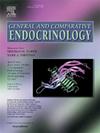Multi-year profiles of T3 are positively correlated with corticosterone in male bowhead whale baleen
IF 1.7
3区 医学
Q3 ENDOCRINOLOGY & METABOLISM
引用次数: 0
Abstract
Thyroid hormones play an important role in the regulation of growth, development, metabolism, thermoregulation, and migration. Very little information exists on patterns of thyroid hormone concentrations in healthy mysticete whales, as many studies have focused on ill, entangled, or stranded whales, making it difficult to interpret thyroid hormone trends. In this study, we used a unique sample-set of bowhead whale baleen plates to explore the long-term interrelationships between triiodothyronine (T3), the most biologically active thyroid hormone, corticosterone, testosterone, and nitrogen isotope ratios (δ15N) (proxies for stress, reproduction, and diet, respectively) to investigate the role T3 may play in the physiology of healthy cetaceans. Baleen plates were collected between 1998 and 2011 from eight subsistence-harvested male bowhead whales across the Eastern Canadian Arctic. Each baleen plate generated 88–158 serial samples, representing ∼11–22 years of life for each individual whale. T3 concentrations ranged from 0.61 to 21.62 ng/g and varied seasonally in just two whales. Most whales showed no correlation between T3 and seasonal fluctuations in testosterone or δ15N, suggesting that variation in T3 is not driven by seasonal shifts in reproductive cycles, consumer trophic level, or migration. However, a strong positive correlation between T3 and corticosterone was observed in every whale, which we hypothesized was due to non-seasonal factors that simultaneously increase metabolic rate and physiological stress. The positive correlation between T3 with corticosterone suggests that in mysticete whales, some stressors may require increased energetic output.
雄性弓头鲸须中T3的多年谱与皮质酮呈正相关。
甲状腺激素在调节生长、发育、代谢、体温调节和迁移等方面发挥重要作用。关于健康神秘鲸体内甲状腺激素浓度模式的信息很少,因为许多研究都集中在生病、被纠缠或搁浅的鲸鱼身上,因此很难解释甲状腺激素的趋势。在这项研究中,我们利用一组独特的弓头鲸须骨板样本,探索了三碘甲状腺原氨酸(T3),最具生物活性的甲状腺激素,皮质酮,睾酮和氮同位素比率(δ15N)(分别代表压力,繁殖和饮食)之间的长期相互关系,以研究T3在健康鲸类生理中的作用。1998年至2011年间,研究人员从加拿大东部北极地区的8头雄性弓头鲸身上收集了鲸须片。每个鲸须板产生88-158个连续样本,代表每只鲸鱼的寿命~ 11-22 年。T3浓度范围为0.61-21.62 ng/g,仅两只鲸鱼的浓度随季节变化。大多数鲸鱼的T3与睾酮或δ15N的季节性波动之间没有相关性,这表明T3的变化不是由生殖周期、消费者营养水平或迁徙的季节性变化驱动的。然而,在每只鲸鱼中,T3和皮质酮之间都观察到很强的正相关,我们假设这是由于非季节性因素同时增加了代谢率和生理应激。T3与皮质酮之间的正相关表明,在神秘鲸中,一些压力源可能需要增加能量输出。
本文章由计算机程序翻译,如有差异,请以英文原文为准。
求助全文
约1分钟内获得全文
求助全文
来源期刊

General and comparative endocrinology
医学-内分泌学与代谢
CiteScore
5.60
自引率
7.40%
发文量
120
审稿时长
2 months
期刊介绍:
General and Comparative Endocrinology publishes articles concerned with the many complexities of vertebrate and invertebrate endocrine systems at the sub-molecular, molecular, cellular and organismal levels of analysis.
 求助内容:
求助内容: 应助结果提醒方式:
应助结果提醒方式:


